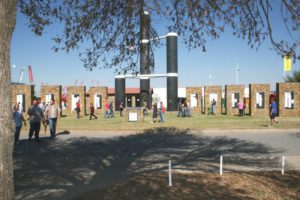2017-05-19 08:38
Amanda Khoza, News24

A farmer observes the names of farmers killed in farm attacks at the Wall of Remembrance in Nampo Park in Bothaville, Free State. (Amanda Khoza/News24)
This week, families visited the monument during the Nampo Harvest Day festival and added the names of loved ones killed in farm murders.
“The monument is a memorial to farmers who gave their lives, not in defending the country, but in trying to feed South Africa,” Agri SA’s Johannes Moller said.
A wall of remembrance was erected about 10 years ago, to honour all commercial farmers and their relatives who had been murdered since May 1961. The names are engraved on nine stone structures representing the country’s nine provinces.
Three pillars represent a husband, wife, and child. At the centre of the monument is a statue of a young man with his arm raised and holding a Bible, to signify farmers’ dependence on the mercy of God.
Moller said the monument represents the dark side of agriculture. He said Agri SA recently set up a trauma service due to increasing demand for counselling from farm workers and other people affected by farm murders.
Farm murders had been on the decrease, but this year the scourge had started increasing again.
‘Effect on food security’
“To some extent it has a connection with poverty and unemployment and because farms can be considered soft targets. That is probably why we are seeing an increase.”
He said the country’s 36 000 commercial farmers produced most of its food.
“Every farmer is responsible for feeding more than 1 500 people in the cities and towns, and that is why it is so tragic. Farm murders affect not only agriculture as an industry, but it will eventually have an effect on food security in South Africa.”
He said the organisation was proactively trying to enable farmers to protect themselves.
According to an Africa Check report on farm murders citing police figures, 49 people were murdered in farm attacks in 2015 and 2016.
They struggled to understand the brutality of some of the murders. Moller said he had seen farm attacks during which the victims had been skinned alive.
“I have seen little children who have been kicked and beaten in such a brutal fashion that their heads swell bigger than a soccer ball.
“I have seen cases where people were forced to drink boiling water.
“It is not just the farmers that are murdered, it is farm workers as well. The murders are not exclusive to white farmers, it’s farmers of all races being killed.”
‘Most dangerous job in SA’
Moller said farmers had good co-operation from the police.
“When we have security meetings, it is really the top brass that attend. We also have the rural security policy that was developed jointly between Agri SA and the police service, but their constraint is also funding.”
In more than 90% of cases, the attacks did not involve people living or working on the farms, but rather outsiders and syndicates.
“Criminals want to keep the police busy because they know that once there has been a farm attack, they know that the police will focus on the farm attacks so that they can do other acts of crime in the area, so they distract the police.”
The Free State, North West, and Gauteng were the hardest hit by farm murders, he said.
The murders had a negative impact on the attractiveness of agriculture as a career.
“If you have a choice of where you are going to make a living as a young person, you probably know that the second-most dangerous job in South Africa is being a police officer, and the most dangerous one is being a farmer or a farm worker.”
The sector needed to come up with new technology to stop such crimes.
“So that immediately when you think there is a farm attack, we can activate the rural safety plan, the police, neighbours, and everyone involved,” he said.
http://www.news24.com/SouthAfrica/News/remembering-the-farmers-who-died-trying-to-feed-sa-20170519


